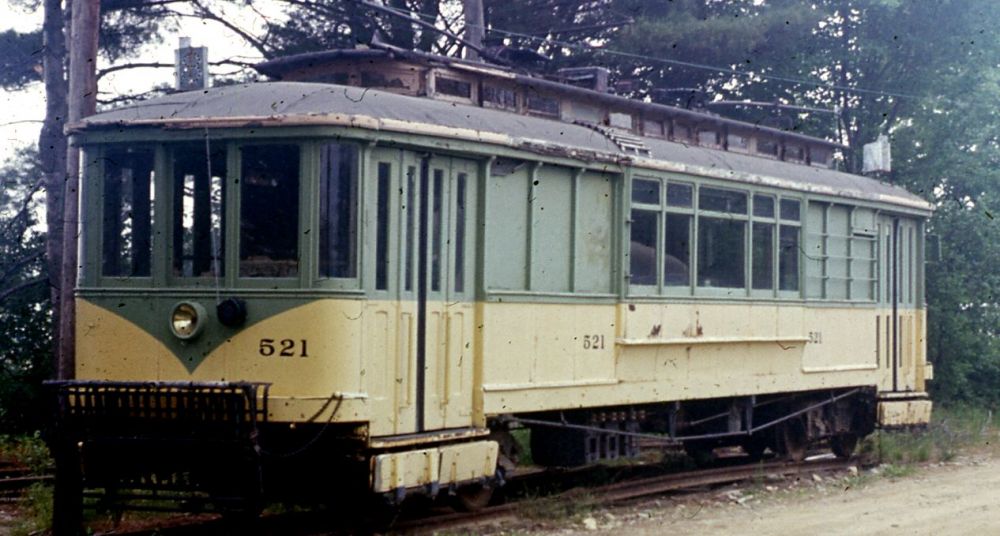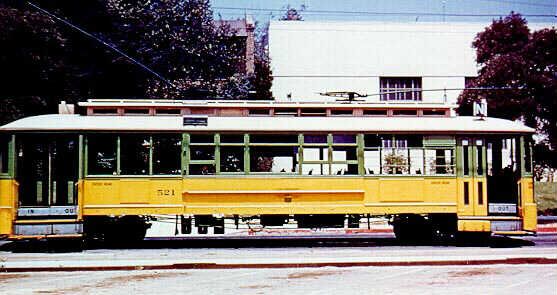
Norman Down
- Builder
- St. Louis Car Co.
- Description
- California suburban, LARy Class BG
- Secondary Use
- None
- Type
- City and Suburban Streetcars
- Year
- 1906
- Retired from Service
- 1954
- Acquired by the Museum
- 1954
- Fund
- None
Los Angeles Railway 521
From Los Angeles, California
History
Unlike New York and Chicago, where multi-story buildings predominated, Los Angeles instead grew outward, dominated by low-rise architecture. Since the population density could not support a subway or elevated system, the city instead depended on lengthy, local transit lines, supporting various business districts along their routes. The Los Angeles Railway operated a network of 3’ 6” narrow gauge streetcar lines. In addition, the standard gauge Pacific Electric Railway operated a system of interurban lines and local Los Angeles streetcar lines. Los Angeles Railway trolleys carried a yellow paint scheme, in contrast to the red Pacific Electric cars.
Climate played a role in the development of the area’s transport system, where cars with both open and closed sections provided respite from sun, heat and occasional rain. The most common type of car was the California style body, with two mostly open sections on either side of a closed section. Between 1902 and 1912, the Los Angeles Railway acquired nearly 750 California cars, mostly from St. Louis Car Co. These were known as the “Huntington Standard” type, named for Henry Huntington who controlled the Los Angeles Railway. The “Huntington Standard” featured a curved corner windshield. Many early movies showed these cars. Los Angeles Railway purchased “Huntington Standard” No. 521 in 1906. In 1931, LARy replaced the center section longitudinal seats with walkover seats, matching walkover seats in the open sections. The railway converted No. 521 to one-man operation in 1937. Los Angeles Railway became Los Angeles Transit Lines in 1945. No. 521’s final maintenance was a fresh paint job on April 27, 1950. A few months later, on September 10, 1950, No. 521 went into storage. The car had run a total of 1,334,282 miles.
Los Angeles Transit Lines donated No. 521 to Seashore in 1954. Seashore transported No. 521 to Maine by ship via the Panama Canal. At the time, this was the longest equipment move by any railway museum. It was also the first time a streetcar had been delivered into the Port of Boston. Unusually, the car came with a complete record of all its modifications and maintenance. In 1993, Pacific Electric No. 680, a standard gauge streetcar that ran in Los Angeles, joined No. 521 at the museum. The structure of No. 521’s narrow gauge trucks and carbody will not allow re-gauging or re-trucking the car. Thus, it is restricted to the section of track it now occupies and will not be restored to operating condition.
Technical Information
- Seats: 44
- Control: K-35JJ
- Brakes: SM-3
- Compressor: DH-16
Trucks
- Number: 2
- Manufacturer: LA Railway
- Model: T-3
Motor
- Number: 4
- Manufacturer: General Electric
- Model: 265C
Weight and Dimensions
- Length: 44’ 7.00"
- Width: 8’ 3.00"
- Height: 12’
- Weight: 43000 lbs.
Additional Images

Bill Volkmer Collection at newdavesrailpix.com on Aug 23, 1942 at Monroe St at L.A. Community College
© 1998 - 2025 New England Electric Railway Historical Society. All Rights Reserved.